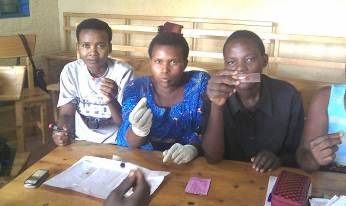In 2009, Rwanda adopted a new national policy that requires parasitological/immunological confirmation prior to treatment in all age groups. At the community level, RDTs were introduced for confirmation of malaria before treatment in children under five.

Community health workers practice using RDTs during a training in Gasabo District, Kigali Province. Source: MCHIP
Prior to 2005, malaria was the leading cause of morbidity and mortality in Rwanda, with periodic epidemic outbreaks in the high altitude areas. It accounted for more than 50 percent of outpatient attendance in the health centers and up to 6 percent of case fatality cases in district hospitals. However, following a rapid scale-up of malaria interventions, Rwanda has achieved dramatic reductions in malaria cases and deaths. Driving these efforts was strong political will and leadership from the Rwandan government as well as solid support from partners.
In addition, community health workers played a vital role in translating the national strategy into practice by providing information and resources for prompt and effective malaria treatment and prevention in local communities. In October 2006, Rwanda rolled out artemisinin-based combination therapy (ACT) countrywide at the health center level. In 2007, the use of ACTs for treatment of uncomplicated malaria was extended to the community level through a network of 30,000 community health workers.
Until recently, malaria treatment in children under five relied mostly on clinical diagnosis. With the spread of antimalarial drug resistance, accurate diagnosis has become an important means of ensuring that malaria treatment is administered only when the presence of malaria parasites is confirmed. Moreover, with decreasing malaria transmission and the introduction of ACTs, presumptive antimalarial treatment for all fever cases could lead to gross overestimation of the true incidence of malaria and excessive use of the more expensive ACTs. In 2009, Rwanda adopted a new national policy that requires parasitological/immunological confirmation prior to treatment in all age groups. At the community level, RDTs were introduced for confirmation of malaria before treatment in children under five.
To support implementation of this policy, the PMI-funded Maternal and Child Health Integrated Program (MCHIP) supported the Government of Rwanda to roll out RDT use in 5 of Rwanda’s 30 districts from January 2011 to July 2012. More than 6,000 community health workers received refresher trainings in community case management, including the use of RDTs. A goal of this training is for community health workers to use RDTs to distinguish between malaria-induced and non-malaria-induced fevers and subsequently treat fever appropriately. One community health worker reported, “RDTs have helped a lot. Now there is no misuse of ACTs. Currently, you can have 1 malaria case out of 50 cases of fever. When we were treating presumptive malaria cases, we could miss other causes of fever with delay in starting the appropriate treatment.” Another says, “It is a good thing, using RDTs. Now mothers have a lot of confidence in us… [And] we can easily follow trends in malaria because we now know the correct diagnosis.”
